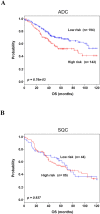An 8-gene signature for prediction of prognosis and chemoresponse in non-small cell lung cancer
- PMID: 27863408
- PMCID: PMC5349935
- DOI: 10.18632/oncotarget.13357
An 8-gene signature for prediction of prognosis and chemoresponse in non-small cell lung cancer
Abstract
Identification of a potential gene signature for improved diagnosis in non-small cell lung cancer (NSCLC) patient is necessary. Here, we aim to establish and validate the prognostic efficacy of a gene set that can predict prognosis and benefits of adjuvant chemotherapy (ACT) in NSCLC patients from various ethnicities. An 8-gene signature was calculated from the gene expression of 181 patients using univariate Cox proportional hazard regression analysis. The prognostic value of the signature was robustly validated in 1,477 patients from five microarray independent data sets and one RNA-seq data set. The 8-gene signature was identified as an independent predictor of patient survival in the presence of clinical parameters in univariate and multivariate analyses [hazard ratio (HR): 2.84, 95% confidence interval CI (1.74-4.65), p=3.06e-05, [HR] 2.62, 95% CI (1.51-4.53), p=0.001], respectively. Subset analysis demonstrated that the 8-gene signature could identify high-risk patients in stage II-III with improved survival from ACT [(HR) 1.47, 95% CI (1.01-2.14), p=0.044]. The 8-gene signature also stratified risk groups in EGFR-mutated and wild-type patients. In conclusion, the 8-gene signature is a strong and independent predictor that can significantly stratify patients into low- and high-risk groups. Our gene signature also has the potential to predict patients in stage II-III that are likely to benefit from ACT.
Keywords: chemosensitivity; microarray analysis; non-small cell lung cancer; prognosis.
Conflict of interest statement
Conflict of interest relevant to this article was not reported.
Figures






Similar articles
-
The prognostic effect of single and multiple cancer-related somatic mutations in resected non-small-cell lung cancer.Lung Cancer. 2018 Sep;123:22-29. doi: 10.1016/j.lungcan.2018.06.023. Epub 2018 Jun 19. Lung Cancer. 2018. PMID: 30089591
-
Prognostic and predictive gene signature for adjuvant chemotherapy in resected non-small-cell lung cancer.J Clin Oncol. 2010 Oct 10;28(29):4417-24. doi: 10.1200/JCO.2009.26.4325. Epub 2010 Sep 7. J Clin Oncol. 2010. PMID: 20823422 Free PMC article.
-
Survival outcome according to KRAS mutation status in newly diagnosed patients with stage IV non-small cell lung cancer treated with platinum doublet chemotherapy.Oncotarget. 2015 Oct 6;6(30):30287-94. doi: 10.18632/oncotarget.4711. Oncotarget. 2015. PMID: 26471290 Free PMC article.
-
Prognostic value of KRAS mutation in advanced non-small-cell lung cancer treated with immune checkpoint inhibitors: A meta-analysis and review.Oncotarget. 2017 Jul 18;8(29):48248-48252. doi: 10.18632/oncotarget.17594. Oncotarget. 2017. PMID: 28525386 Free PMC article. Review.
-
Prognostic markers in lung cancer: is it ready for prime time?Transl Lung Cancer Res. 2014 Jun;3(3):149-58. doi: 10.3978/j.issn.2218-6751.2014.06.09. Transl Lung Cancer Res. 2014. PMID: 25806294 Free PMC article. Review.
Cited by
-
Benefits from Adjuvant Chemotherapy in Patients with Resected Non-Small Cell Lung Cancer: Possibility of Stratification by Gene Amplification of ACTN4 According to Evaluation of Metastatic Ability.Cancers (Basel). 2022 Sep 7;14(18):4363. doi: 10.3390/cancers14184363. Cancers (Basel). 2022. PMID: 36139525 Free PMC article. Review.
-
DNA hypomethylation-related overexpression of SFN, GORASP2 and ZYG11A is a novel prognostic biomarker for early stage lung adenocarcinoma.Oncotarget. 2019 Feb 26;10(17):1625-1636. doi: 10.18632/oncotarget.26676. eCollection 2019 Feb 26. Oncotarget. 2019. PMID: 30899432 Free PMC article.
-
Identification of Prognosis-Related Genes in Bladder Cancer Microenvironment across TCGA Database.Biomed Res Int. 2020 Nov 3;2020:9143695. doi: 10.1155/2020/9143695. eCollection 2020. Biomed Res Int. 2020. PMID: 33204728 Free PMC article.
-
Bioinformatics Analysis to Screen the Key Prognostic Genes in Tumor Microenvironment of Bladder Cancer.Biomed Res Int. 2020 Feb 17;2020:6034670. doi: 10.1155/2020/6034670. eCollection 2020. Biomed Res Int. 2020. PMID: 32149116 Free PMC article.
-
Beyond PD-L1 testing-emerging biomarkers for immunotherapy in non-small cell lung cancer.Ann Transl Med. 2017 Sep;5(18):376. doi: 10.21037/atm.2017.06.48. Ann Transl Med. 2017. PMID: 29057236 Free PMC article. Review.
References
-
- Torre LA, Bray F, Siegel RL, Ferlay J, Lortet-Tieulent J, Jemal A. Global cancer statistics, 2012. CA Cancer J Clin. 2015;65:87–108. - PubMed
-
- Ettinger DS, Akerley W, Borghaei H, Chang AC, Cheney RT, Chirieac LR, D’Amico TA, Demmy TL, Govindan R, Grannis FW, Jr., Grant SC, Horn L, Jahan TM, et al. Non-small cell lung cancer, version 2.2013. J Natl Compr Canc Netw. 2013;11:645–653. quiz 653. - PubMed
-
- Langer CJ, Besse B, Gualberto A, Brambilla E, Soria JC. The evolving role of histology in the management of advanced non-small-cell lung cancer. J Clin Oncol. 2010;28:5311–5320. - PubMed
-
- Chansky K, Sculier JP, Crowley JJ, Giroux D, Van Meerbeeck J, Goldstraw P, C International Staging, Participating I. The International Association for the Study of Lung Cancer Staging Project: prognostic factors and pathologic TNM stage in surgically managed non-small cell lung cancer. J Thorac Oncol. 2009;4:792–801. - PubMed
MeSH terms
Substances
LinkOut - more resources
Full Text Sources
Other Literature Sources
Medical
Research Materials
Miscellaneous

